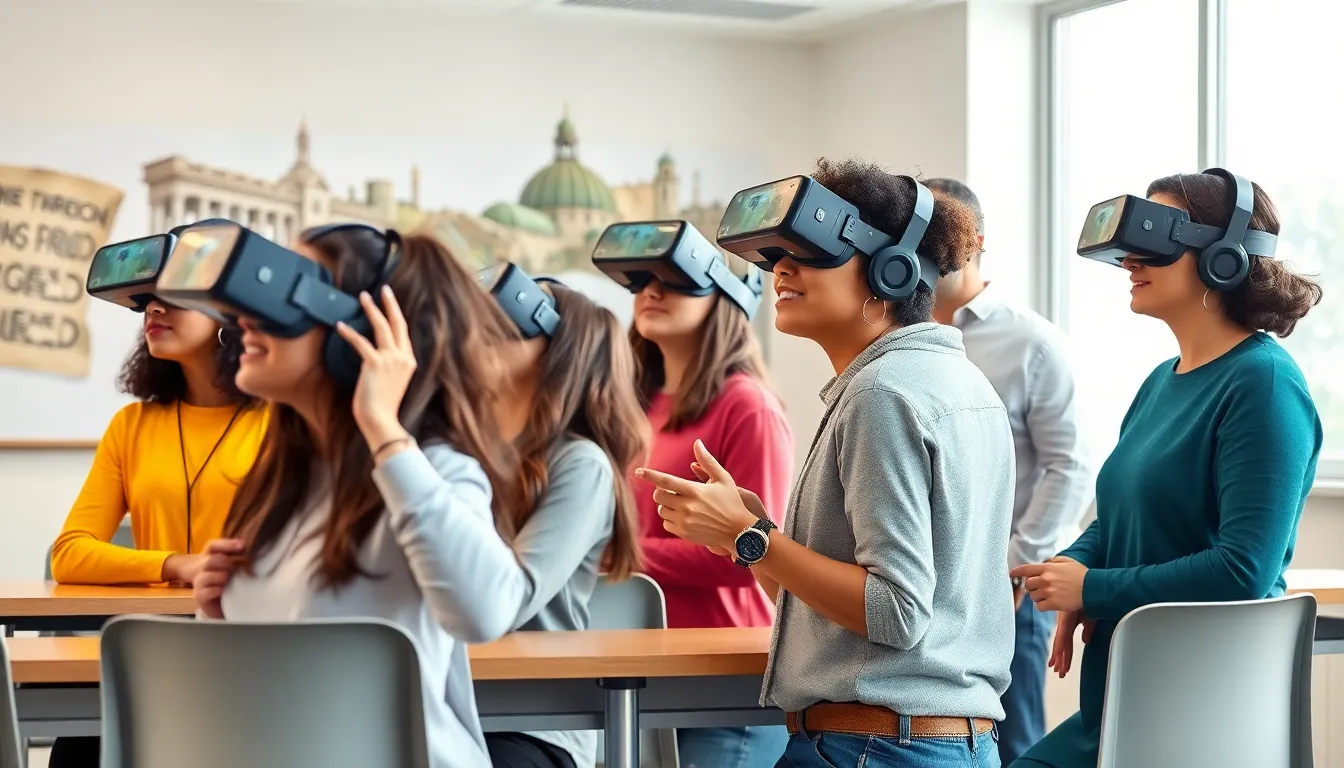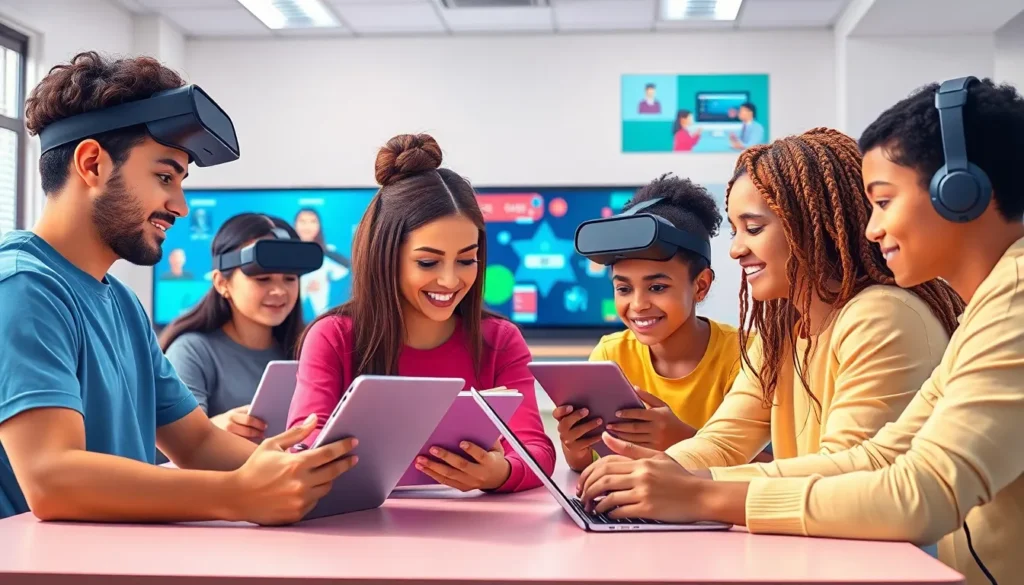In the ever-evolving world of education, technology isn’t just a sidekick; it’s the superhero that swoops in to save the day. From virtual classrooms that make geography feel like a breeze to AI tutors that can explain algebra better than your high school teacher ever could, educational technology is reshaping how students learn and teachers teach.
As classrooms transform into digital playgrounds, it’s hard not to get excited about the latest trends. Whether it’s gamification that turns learning into a thrilling adventure or immersive VR experiences that transport students to ancient civilizations, the future of education is brighter—and a lot more fun—than ever. Buckle up as we dive into the trends that are making waves and keeping educators on their toes.
Trends in Educational Technology
Educational technology trends continue to evolve, shaping how students and educators engage with learning. The adoption of artificial intelligence (AI) in education enhances personalized learning experiences. AI tools analyze student data, providing tailored feedback and resources, fostering individual growth.
Additionally, blended learning models integrate online and in-person instruction. This approach allows flexibility, catering to diverse learning preferences. The rise of gamification keeps students motivated by incorporating game mechanics into lessons.
Moreover, immersive technologies like virtual reality (VR) create engaging learning environments. VR enables students to explore simulations and scenarios not possible in a traditional classroom. Such experiences contribute to deeper understanding and retention of complex subjects.
Collaboration tools also gain traction, promoting interaction among students and teachers. Platforms like Microsoft Teams or Google Classroom facilitate real-time communication and resource sharing. This connectivity encourages teamwork and enhances the educational experience.
Increased access to online resources expands learning opportunities. Students utilize platforms such as Khan Academy or Coursera for supplementary material. The wealth of information available helps learners pursue knowledge beyond the classroom.
Finally, data analytics has become a vital component of educational institutions. Schools leverage analytics to track student progress and identify areas for improvement. This data-driven approach supports informed decision-making and resource allocation.
Trends in educational technology are reshaping the learning landscape, making education more accessible, engaging, and effective for everyone involved.
Emerging Technologies in Education

Emerging technologies significantly influence educational practices and enhance learning experiences. Innovations like artificial intelligence and virtual reality reshape the classroom environment.
Artificial Intelligence in the Classroom
Artificial intelligence (AI) personalizes education by providing tailored feedback to students. Teachers use AI-driven platforms to analyze individual learning styles and adapt resources accordingly. This technology creates customized learning pathways, allowing students to progress at their own pace. Companies such as DreamBox Learning and Carnegie Learning illustrate successful implementations of AI tools. Enhanced engagement occurs as AI facilitates interactive learning, making subjects accessible and enjoyable.
Virtual and Augmented Reality Applications
Virtual and augmented reality (VR and AR) applications revolutionize educational experiences by immersing students in interactive environments. These technologies allow learners to explore historical events or complex scientific concepts in a simulated space. For instance, Google Expeditions enables virtual field trips, providing unique insights into global landmarks. Furthermore, AR tools, like Merge Cube, blend real-world objects with digital content to deepen understanding. Engaging with content in this manner fosters curiosity, motivation, and a richer educational experience.
The Role of Data Analytics
Data analytics plays a critical role in modern education by providing insights that enhance learning experiences. Institutions leverage data to support personalized learning, streamline assessment processes, and inform instructional strategies.
Personalized Learning Experiences
Data analytics enables the customization of learning pathways for individual students. By analyzing data sets, educators identify learning preferences and performance patterns. Platforms like DreamBox Learning demonstrate this approach, adjusting content dynamically based on real-time student interactions. Immediate feedback is provided, allowing learners to gain insights into their progress. In addition, tailored resources meet diverse needs, ensuring every student engages fully in their education.
Assessing Student Performance
Effective assessment practices benefit significantly from data analytics. Institutions collect and analyze performance data to gauge student understanding and retention. Tools such as Learning Management Systems (LMS) utilize analytics to monitor progress and identify areas needing improvement. Educators can pinpoint trends in class performance, which informs instructional adjustments. Moreover, ongoing assessment fosters continuous improvement, creating a responsive learning environment. This proactive approach transforms the way educators support student success.
The Impact of Mobile Learning
Mobile learning significantly enhances student engagement and access to educational resources. Students often utilize smartphones, tablets, and laptops to interact with learning materials, facilitating education anytime and anywhere. This flexibility appeals to diverse learning styles, accommodating those who prefer on-the-go learning experiences.
Research shows that 77% of students use mobile devices for educational purposes, illustrating how integral these tools are in modern education. The accessibility of mobile learning empowers learners to revisit lessons and complete assignments at their convenience. Institutions increasingly develop mobile-friendly content to support this trend, ensuring compatibility across various platforms.
Apps designed for education, such as Quizlet and Duolingo, enhance collaborative and independent learning experiences. These applications often incorporate gamification elements to boost motivation and retention, making learning enjoyable. For example, Duolingo promotes language acquisition through interactive exercises, allowing users to practice skills daily.
Additionally, mobile learning fosters communication between educators and students. Messaging platforms and discussion boards facilitate real-time feedback, creating an open dialogue for questions and clarifications. Consequently, teachers can monitor student progress closely and adapt instructional strategies based on immediate input.
Affordability and convenience shape the future of mobile learning, with many free resources available online. Platforms like Khan Academy and Coursera provide high-quality education without a financial burden. The proliferation of mobile learning continues to break down barriers, promoting equal access to educational opportunities for all learners.
Mobile learning transforms the educational landscape by enhancing accessibility, engagement, and communication. By integrating technology into education, institutions prepare students for a dynamic and evolving future.
Collaborative Learning Tools
Collaborative learning tools enhance interaction among students and educators. Platforms like Microsoft Teams and Google Classroom facilitate real-time communication, fostering teamwork. These tools integrate features such as chat, video conferencing, and file sharing, making group projects more efficient.
Engaging students in collaborative activities boosts motivation and reinforces concepts. Utilizing shared documents encourages peer feedback and accountability. This interactive approach promotes deeper understanding and retention of material.
Project management tools such as Trello and Asana keep teams organized and on-task. These applications help students track progress and deadlines, improving project outcomes. Educators can monitor group dynamics and offer support when necessary.
Furthermore, online discussion forums enhance collaboration by allowing students to exchange ideas asynchronously. This flexibility accommodates various schedules and learning styles. Students can revisit discussions, leading to more thoughtful contributions.
Asynchronous video platforms like Flipgrid allow learners to express their thoughts creatively. By recording video responses, students can share insights and connect with peers beyond limitations of traditional settings. This builds a sense of community and belonging among learners.
Emphasizing collaboration helps educators create involved learning environments. By leveraging these tools, teachers can tailor experiences to meet diverse needs. Overall, collaborative learning tools are shaping the educational landscape, ensuring students develop essential skills for the modern world.
Conclusion
As educational technology continues to evolve it’s clear that the landscape of learning is undergoing a significant transformation. Innovations like AI personalized learning blended models and immersive experiences are reshaping how students engage with content. The integration of collaboration tools and mobile learning further enhances accessibility and interaction among students and educators.
These trends not only foster a more engaging educational environment but also empower learners to take control of their educational journeys. Staying informed about these advancements is crucial for educators and institutions aiming to adapt and thrive in this dynamic landscape. The future of education is bright and full of possibilities as technology continues to drive progress.

